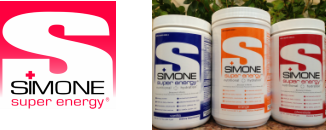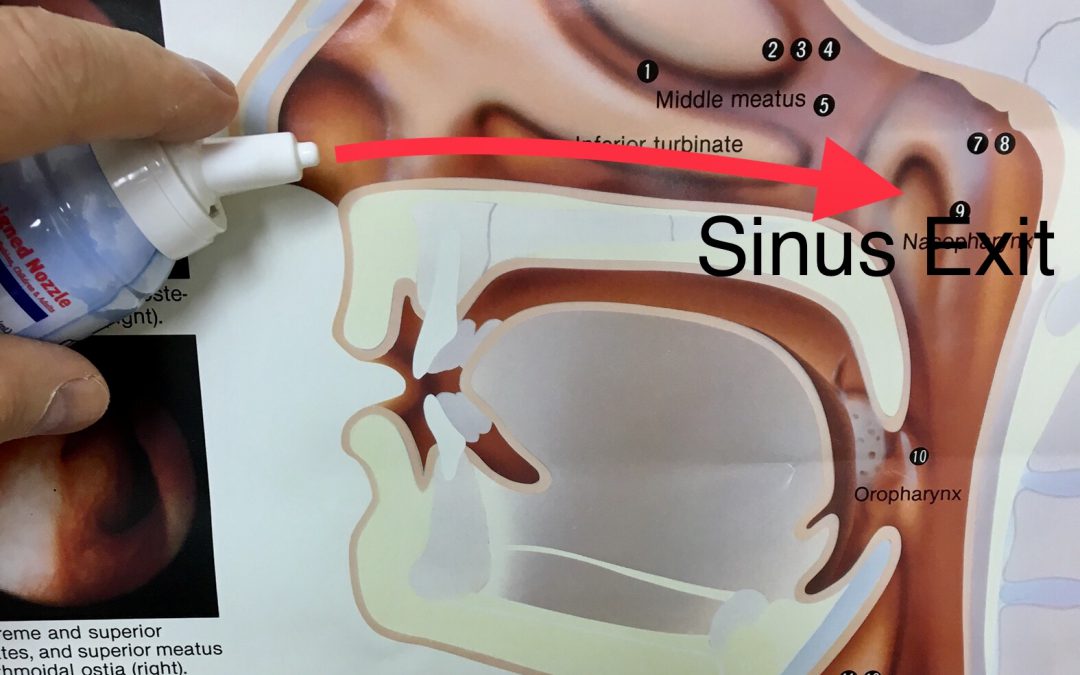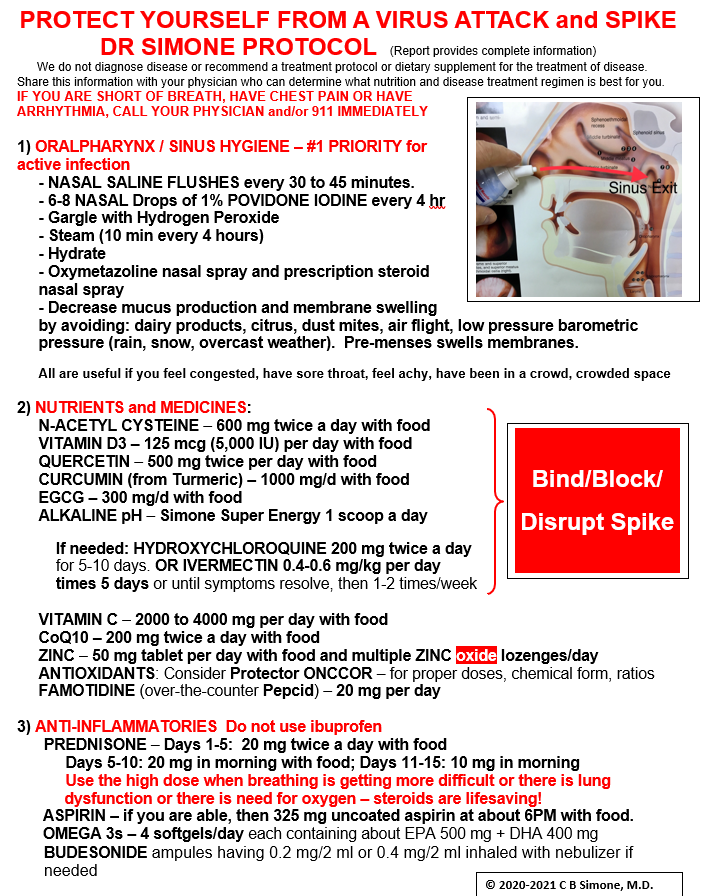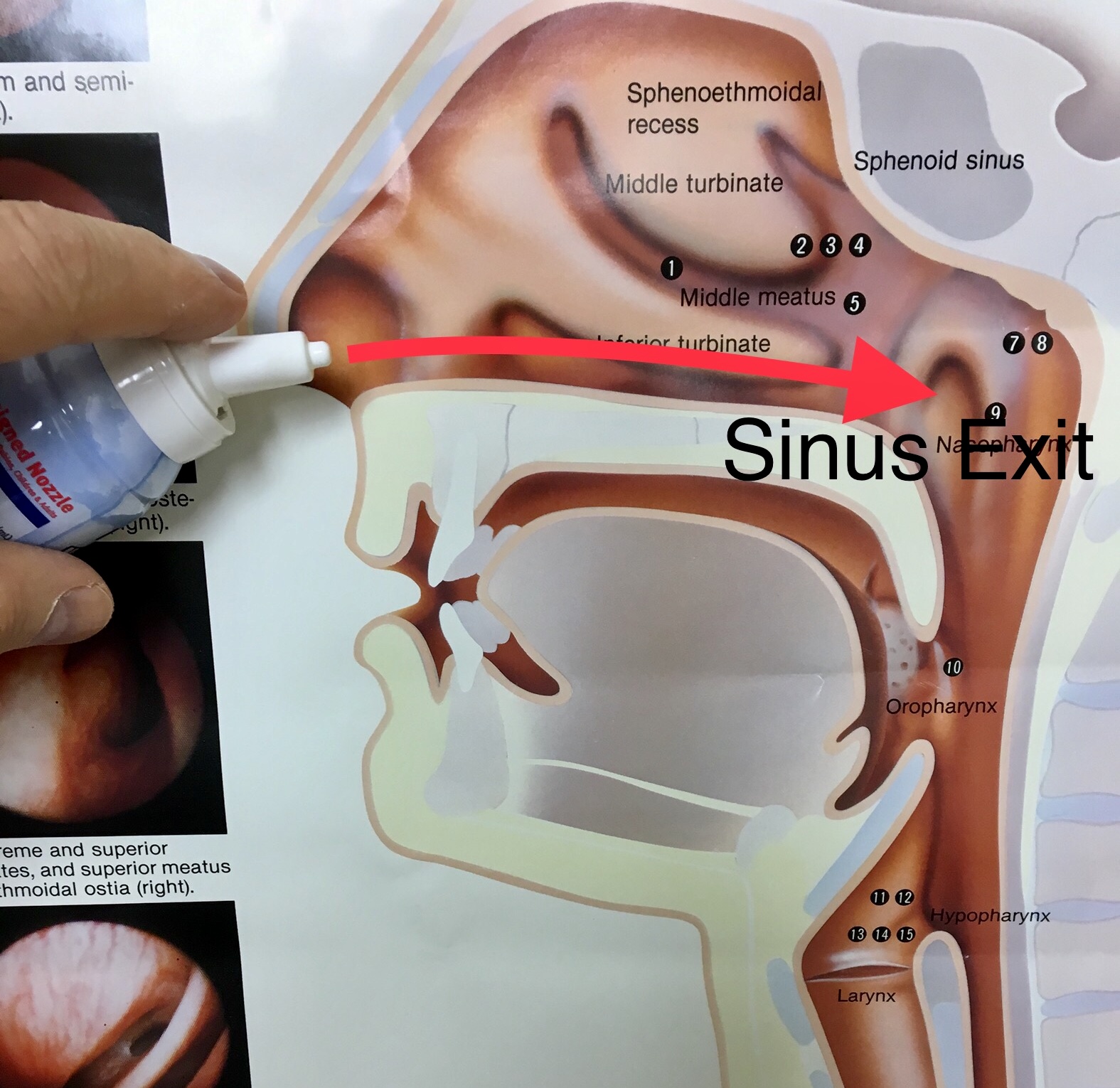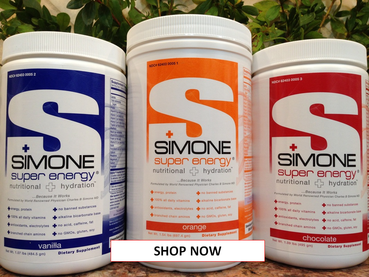We do not diagnose disease or recommend a dietary supplement for the treatment of disease. You should share this information with your physician who can determine what nutrition, disease and injury treatment regimen is best for you. You can search this site or the web for topics of interest that I may have written (use Dr Simone and topic).
“We provide truthful information without emotion or influence from the medical establishment, pharmaceutical industry, national organizations, special interest groups or government agencies.” Charles B Simone, M.MS., M.D.
PROTECT YOURSELF FROM A VIRUS ATTACK
https://bit.ly/3berXi4
Local governments should implement this PLAN (excerpted with permission)
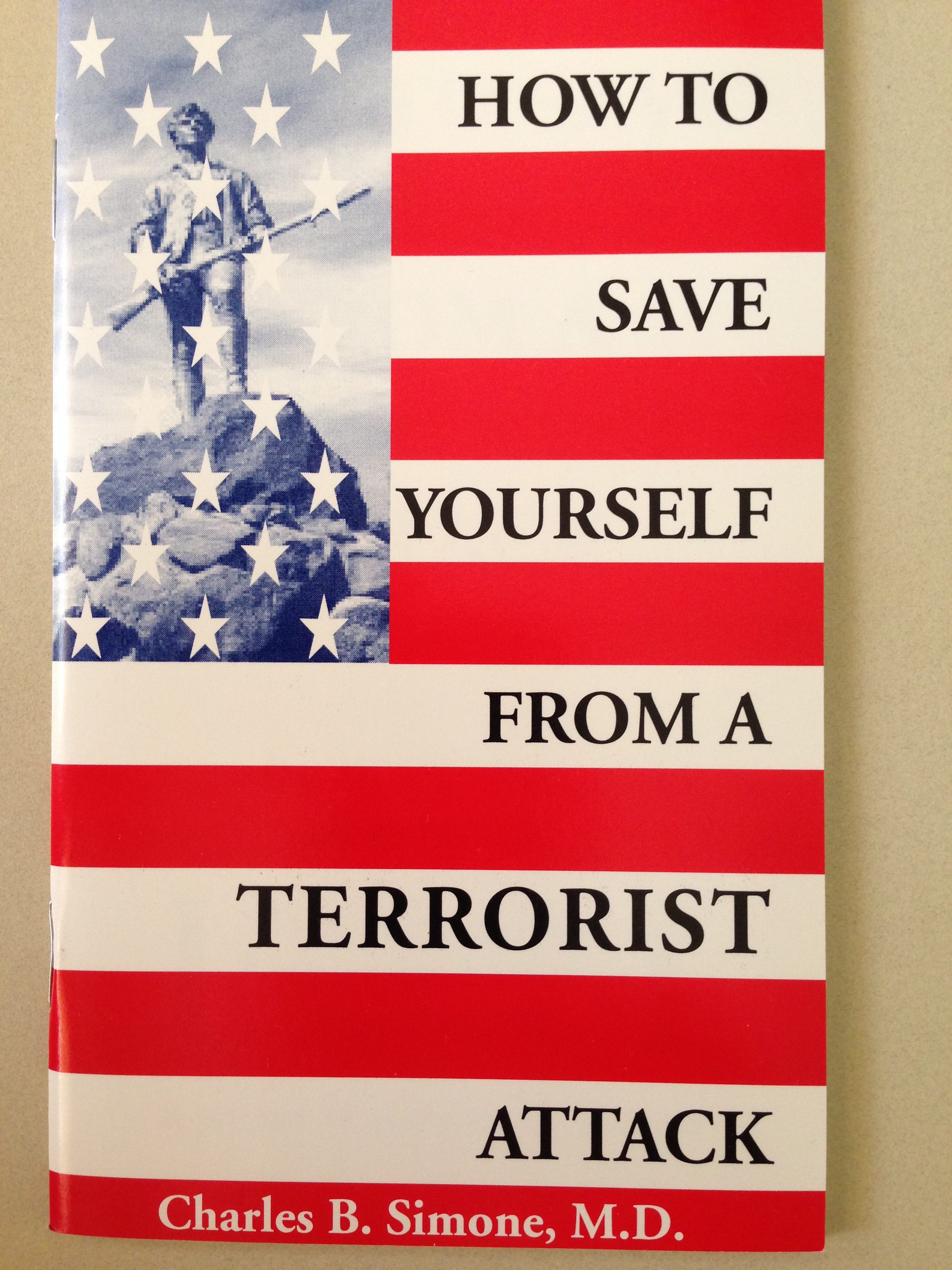 |
HOW TO SAVE YOURSELF FROM A TERRORIST ATTACK by Charles B. Simone, M.D.:Pocket size Manual, 48 pages ISBN 0-9714574-1-7 (September 2001) |
We do not diagnose disease or recommend a dietary supplement for the treatment of disease. You should share this information with your physician who can determine what nutrition, disease and injury treatment regimen is best for you. You can search this site or the web for topics of interest that I may have written (use Dr Simone and topic).
“We provide truthful information without emotion or influence from the medical establishment, pharmaceutical industry, national organizations, special interest groups or government agencies.” Charles B Simone, M.MS., M.D.
ENHANCE YOUR IMMUNE SYSTEM to Decrease Your Risk of Infection
Nutrition –
Maintain an ideal weight.
No four legged animals, shellfish, or dairy products unless they are skim or non-fat.
Organic chicken breasts cooked without the skin.
Swimming fish from the ocean, not the farm.
Fruits and vegetables.
Supplement your diet with certain nutrients in the proper doses, chemical form, and correct ratio of one to another. Take high doses of antioxidants (the carotenes, vitamins C and E, selenium, cysteine, copper, zinc, bioflavonoids), the B vitamins, and calcium with its enhancers: magnesium, potassium bicarbonate, boron, L-lysine, silicon, threonine.
| NUTRIENT |
Protector
ONCCOR™
|
Your Formula |
|
CAROTENOIDS
Beta CAROTENE*
|
30 mg (50,000 IU)
|
|
| LUTEIN* | 20 mcg | |
|
LYCOPENE*
|
20 mcg | |
| Vitamin A (retinyl Palmitate) | 5,000 IU | |
| Vitamin D3 (cholecalciferol) | 500 IU | |
| VITAMIN E* (tocopheryl/succinate) | 400 IU | |
| VITAMIN C* (ascorbic acid) | 350 mg | |
| Folic acid | 400 mcg | |
| Vitamin B1 (thiamin) | 10 mg | |
| Vitamin B2 (riboflavin) | 10 mg | |
| Niacin (niacinamide) | 40 mg | |
| Vitamin B6 (pyridoxine HCl) | 10 mg | |
| Vitamin B12 (cyanocobalamin) | 18 mcg | |
| Biotin | 150 mcg | |
| Pantothenic acid | 20 mg | |
| SELENIUM* (organic) | 200 mcg | |
| COPPER* (cupric oxide) | 3 mg | |
| ZINC* (zinc gluconate) | 30 mg | |
| Iodine (potassium iodide) | 150 mcg | |
| Potassium (potassium chloride) | 30 mg | |
| CHROMIUM* (organic) | 125 mcg | |
| Manganese (gluconate) | 2.5 mg | |
| Molybdenum (proteinate) | 50 mg | |
| Inositol | 10 mg | |
| PABA (para-aminobenzoic acid) | 10 mg | |
| BIOFLAVONOIDS* | 10 mg | |
| Choline (bitartrate) | 10 mg | |
| L-CYSTEINE* (L-cysteine HCl) | 20 mg | |
| L-Arginine HCl | 5 mg |
*Antioxidants
Tobacco – Do not smoke, chew, snuff, or inhale other people’s smoke
Alcohol – less than 2 drinks per week
Walking – briskly for 30 minutes five times a week.
Modify stress
WASH HANDS AND FACE often with soap. Droplets laden with viruses from people who speak to you travel at least three feet from their mouths. Keep your distance and don’t shake hands. Soap and water is the best. Next best is a hand sanitizer with at least 70% alcohol and not hand sanitizers that contain benzalkonium chloride because it may merely reduce the growth of germs rather than kill them.
DROPLET OR AIRBORNE MICROORGANISMS RELEASED FROM VARIOUS ACTIVITIES
| ACTIVITY | PARTICLE COUNT |
| Sneezing | 40,000 per sneeze |
| Bowel Evacuation | 20,000 per event |
| Vomiting | 1,000 per event |
| Coughing | 710 per cough |
| Talking | 36 per 100 words |
DECREASE MUCUS PRODUCTION AND MEMBRANE SWELLING by avoiding: dairy products, citrus, dust mites, air flight, low pressure barometric pressure (rain, snow, overcast weather). Pre-menses swells membranes.
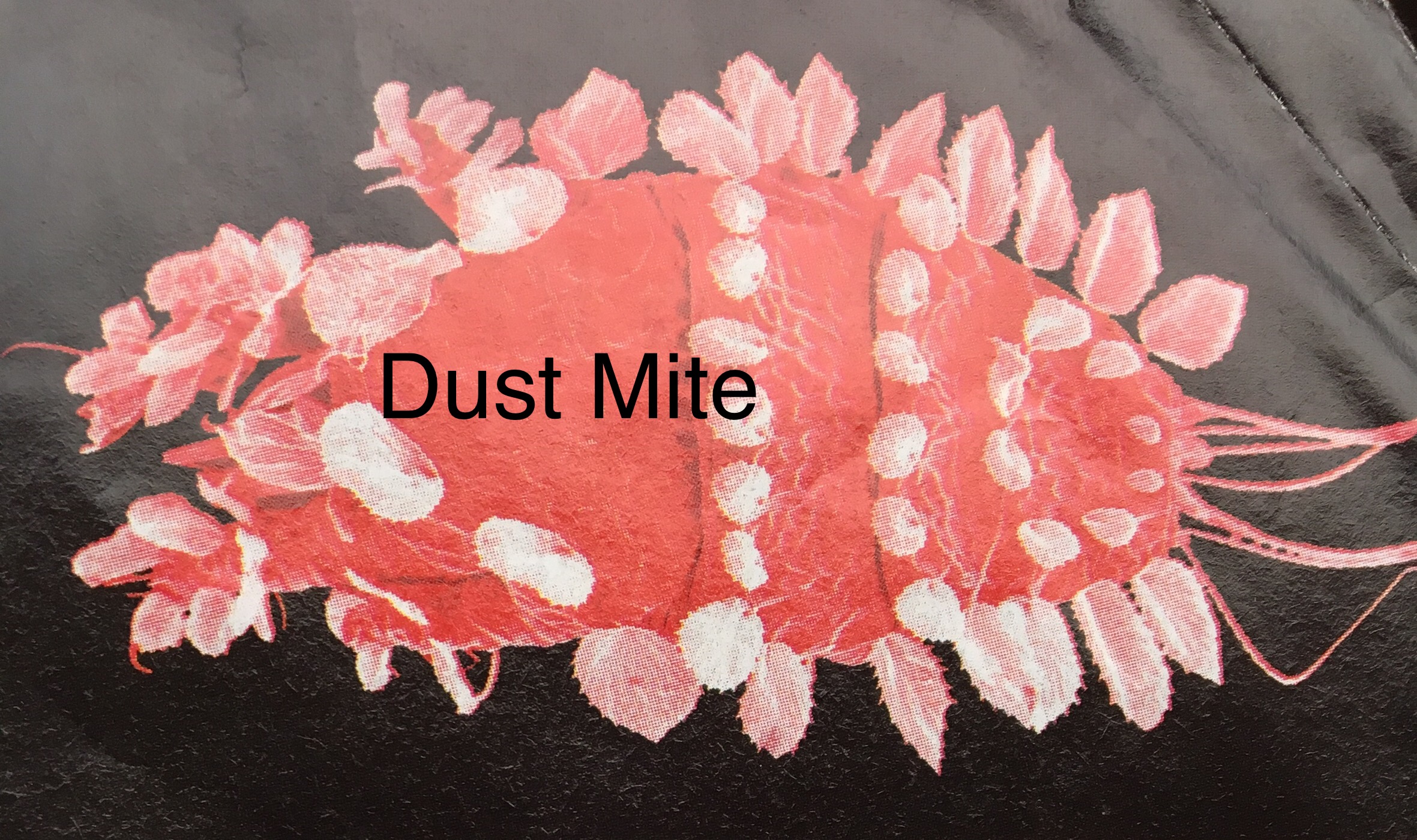 Dust mites live in mattresses, pillows, sheets, blankets, rugs, window dressings, etc. They wait for warm moist bodies – you – and come out by the hundreds of thousands on you, defecate and this causes the allergic reaction that swells sinus exit ports. Use hot water to wash. Cover your mattress and pillows with dust mite covers.
Dust mites live in mattresses, pillows, sheets, blankets, rugs, window dressings, etc. They wait for warm moist bodies – you – and come out by the hundreds of thousands on you, defecate and this causes the allergic reaction that swells sinus exit ports. Use hot water to wash. Cover your mattress and pillows with dust mite covers.
BLEACH – Diluted bleach decontaminates skin and inanimate objects. Viruses generally die on inanimate objects after 12 hours.
Make diluted bleach solution (0.5%) to decontaminate skin from chemicals or biologicals. Even anthrax spores, the most stable of all biologicals, are killed by this solution. Leave this diluted bleach on the skin for about 10-15 minutes. Make this solution by mixing 1 part undiluted bleach from the bottle with 9 parts of water (bleach from the bottle is 5.25%). Make a new solution every day you need it. Avoid eye contact.
SINUS HYGIENE – Keep sinus exit ports open:
SINUS HYGIENE DECREASES VIRAL INFECTION
1) Saline nasal flushes every 30 to 45 minutes – this has antiviral effects (https://www.nature.com/articles/s41598-018-37703-3) and promotes mucus flow so that viruses and bacteria can’t lodge. Insert the spray tip in the nostrils perpendicular to the face and direct it toward the ears to get the spray to the exit ports to open them.
Using a syringe bulb, flushes with specific concentrations of over-the-counter Iodine (two teaspoons in 6 ounces of water), or Hydrogen Peroxide, or even very dilute Bleach (several drops in 6 ounces of water) can be used in the same manner as nasal saline. All these flushes are particularly useful if you have been in a crowd or in a high traffic and poorly ventilated public restroom.
Povidone Iodine (PVP-I) Oro-Nasal Spray: An Effective Shield for COVID-19 Protection for Health Care Worker (HCW), for all https://www.ncbi.nlm.nih.gov/pmc/articles/PMC8026810/
Effect of 1% Povidone Iodine Mouthwash/Gargle, Nasal
and Eye Drop in COVID-19 patient file:///C:/Users/mail/Downloads/176-Article%20Text-335-2-10-20210102.pdf
The American Dental Association Council on Dental Therapeutics has designated 0.1% sodium hypochlorite a ‘mild antiseptic mouth rinse’ and suggested its use for direct application to mucous membranes. Dilute sodium hypochlorite has no contraindications. Its high degree of safety permits frequent and broad usage by both dentists and patients.
SINUS HYGIENE DECREASES VIRAL INFECTION
Imagine yourself trying to swim up these or any other waterfalls. It is not possible. So promote mucus flow so that viruses and bacteria can’t swim up and lodge in your sinuses.2) Steam (10 min every 4 hours) – boil an inch of water in a quart size pot, take it away from the stove, add about 10 drops of Eucalyptus oil, and inhale over the pot with a towel over your head.
3) Oxymetazoline nasal spray has antiviral effects and is not a banned substance (over-the-counter). Use as directed. https://journals.sagepub.com/doi/10.2500/ajra.2010.24.3491
4) Prescription steroid nasal spray to keep inflammation down – this requires a Therapeutic Use Exemption approval during sports competitions. Insert the spray tip in the nostrils perpendicular to the face and direct it toward the ears to get the medicine to the exit ports to open them.
5) Hydrate to keep the mucus thin and flowing.
HYDROGEN PEROXIDE changes the structure of viruses and generates oxygen that kills viruses. Gargle for several minutes with hydrogen peroxide (right from the bottle) twice a day.
ZINC – weekly dose of 70 mg for all ages reduces mortality/morbidity from viruses and bacteria. 50 mg per day when you are exposed or feel sick. Also, Zinc Lozenges.
1) Brooks WA, et al. Lancet. 2005. 366:999-1004. 2) Bhatnagar S. Lancet. 2007. 369:885-886. 3) Sazawal S et al. Lancet. 2007. 369:927-34. 4) Barnett JB et al. Nutr Rev. 2010 Jan; 68(1): 30–37.
N-ACETYL CYSTEINE – 600 mg twice a day. N-acetyl cysteine inhibits virus replication and lung inflammation.
VITAMIN C – 2 to 4 grams each day with food. 200 mg of vitamin C per day resulted in an 80% decrease in deaths among severely ill, hospitalized respiratory disease patients.
Hunt C et al. The clinical effects of Vitamin C supplementation in elderly hospitalized patients with acute respiratory infections. Int J Vitam Nutr Res 1994;64:212-19. https://www.ncbi.nlm.nih.gov/pubmed/7814237
VITAMIN D3 – 5,000 IU per day with food, or the dose needed to raise your blood level to about 80 ng/ml. Vitamin D3 enhances the immune system and also reduces infectivity of SARS-CoV 2 by binding to the viral spike protein thus locking it into a closed position. Steroids have the same effect, but cholesterol increases infectivity. About 40% of COVID-19 patients with abnormally low levels of Vitamin D3 levels ended up in the ICU or had to be hospitalized. Vitamin D is fat soluble and accumulates in fatty tissue. People who are overweight/obese therefore have less Vitamin D3 available in the bloodstream.
Molecular simulations suggest vitamins, retinoids and steroids as ligands binding the free fatty acid pocket of SARS-CoV-2 spike protein. Toelzer et al. Angewandte Chemie. 19 January 2021.https://doi.org/10.1002/anie.202015639 https://onlinelibrary.wiley.com/doi/10.1002/anie.202015639
QUERCETIN – 500 mg twice per day (nutrient, over-the-counter) – interferes with the virus binding onto your cells. Quercetin possesses anti-influenza activity by inhibiting viral entry, viral-cell fusion, viral replication, viral load, and lung inflammation and airways hyper-responsiveness in vivo. Quercetin helps shuttle zinc, a viral killer, into the cell. Quercetin has antibacterial, antifungal and antiviral properties.
Quercetin:
-
Inhibits SARS-CoV-2 spike protein to ACE2 receptor docking.
-
Inhibits the release of proinflammatory cytokines and histamine.
-
Boosts interferon response to viruses.
-
Binds to the spike protein, thereby inhibiting its ability to infect host cells.
-
Inhibits replication of already infected cells.
-
Reduces infected cells’ resistance to treatment with antiviral medication
Wenjiao W, et al. Viruses. 2016. Jan. 8(1):6; Kinker et al. J Infectious Diseases & Preventive Med 2014 2.2.
A reduction in total sick days and severity was noted in middle aged and older subjects ingesting 1000 mg quercetin per day for 12 weeks who rated themselves as physically fit (Heinz SA et al. Pharmacol Res. 2010 Sep;62(3):237-42).
Quercetin outperforms Tamiflu – A mouse study showed that quercetin reduced symptoms and gave higher survival rates. Also, animals treated with Quercetin had half of the virus load in their lungs compared to animals treated with Tamiflu. (Choi HJ, et al. Phytother Res. 2012 Mar;26(3):462-4).
Tamiflu’s chemical structure is similar to Quercetin but different enough to allow it to be patented. Despite all the media attention about Tamiflu, here is what the makers of Tamiflu say in their insert (Nov 2009):
Adults felt better 30 percent faster (1.3 days) than flu patients who did not take TAMIFLU. Children felt better up to 26 percent faster (1.5 days) than flu patients who did not take TAMIFLU
JET PLANES should use only OUTSIDE AIR for cabin.
Speak with your physician and consider using a lysosomotropic agent within the first five days of exposure to SARS-CoV 2 (COVID-19). These medicines cross the lysosomal membrane and become protonated thus increasing the lysosome’s pH (alkaline) rendering the lysosome nonfunctional. These medicines include Hydroxychloroquine and Ivermectin.
HYDROXYCHLOROQUINE SAVES LIVES https://bit.ly/38t2ZKl
IVERMECTIN SAVES LIVES https://bit.ly/3aCNAtl
© 2020 Charles B. Simone, M.MS., M.D.
